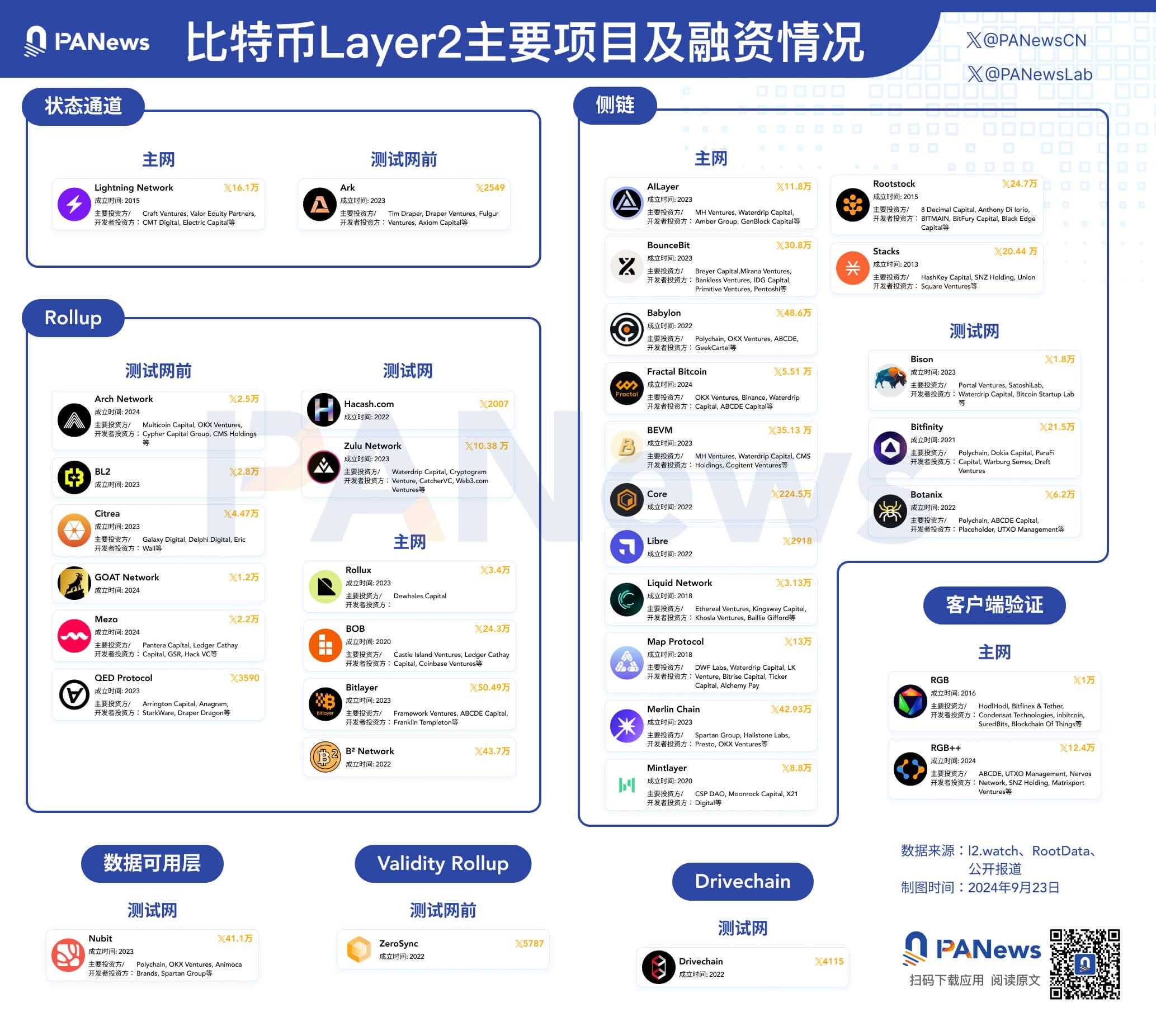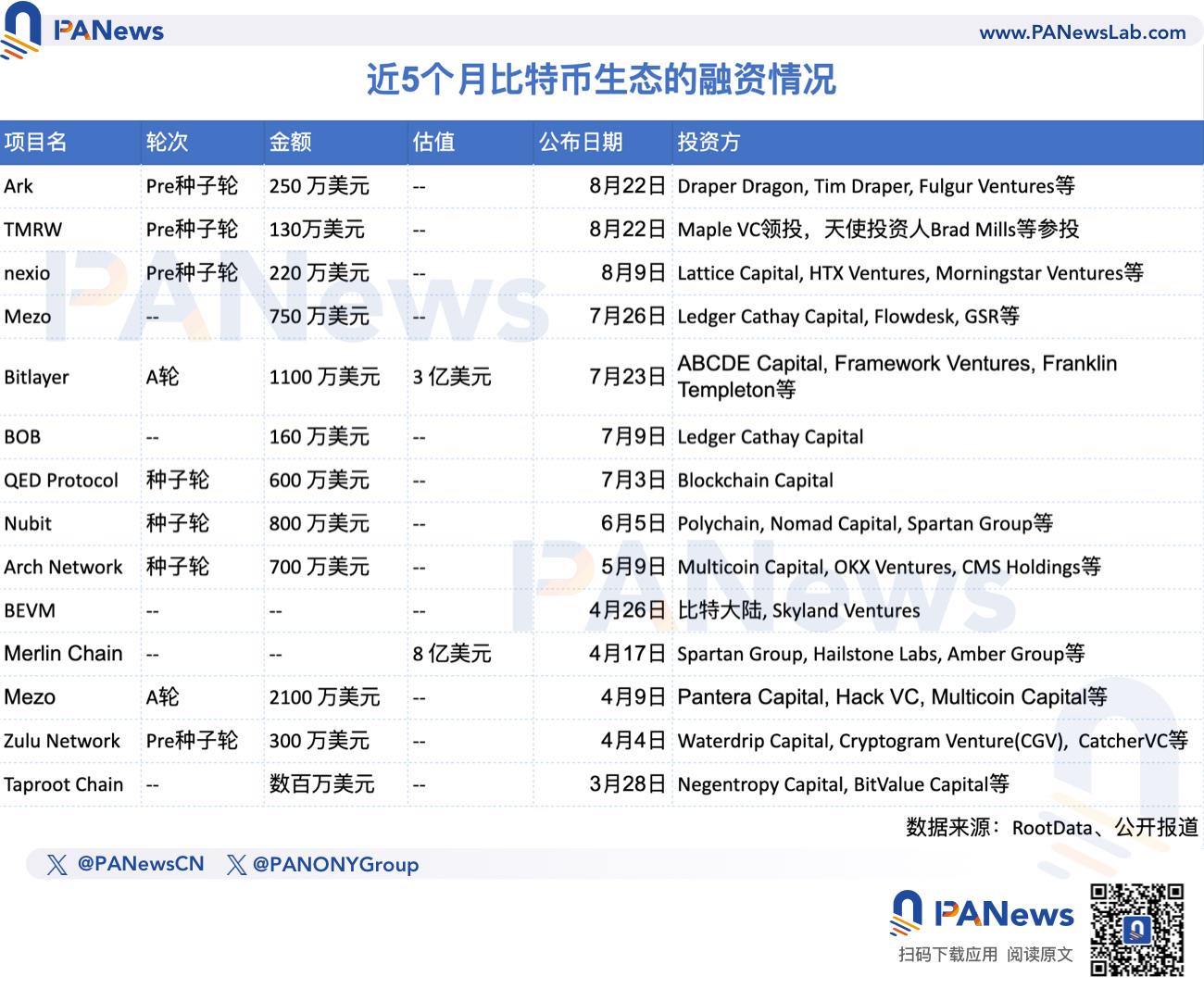A look at the Bitcoin Layer 2 landscape: Sidechains and Rollups become mainstream, and top projects easily attract tens of millions of dollars
Written by: Weilin, PANews
Bitcoin Layer2 is to improve BitcoinBlockchainThe second layer outside the main chain is built to improve scalability, functionality and transaction efficiencyBlockchainAlthough it is often compared with Ethereum Layer2, Bitcoin's expansion will not be possible until the experimental BRC20 based on the Ordinals protocol in May 2023.TokenOnly when the standard becomes popular can more people believe that Bitcoin can not only issue coins, but also realize more complex and sustainable application scenarios.
Currently, according to statistics from l2.watch, there are more than 80 Layer2 projects focusing on Bitcoin expansion. In this article, PANews will sort out the main Layer2 projects that follow different technical routes and introduce the latest project dynamics and financing of Bitcoin Layer2.

The main technical route of Bitcoin Layer 2 at present
State Channels
State channels allow users to establish end-to-end encrypted channels, facilitating multiple off-chain transactions between two or more parties, ensuring that only the first and last transactions are recorded in Bitcoin.Blockchain中,而无需将每笔交易都广播到主区块链。 因此,状态通道可以实现以尽可能低的 gas 费用,支持更大的交易吞吐量。
Representative project: Lightning Network
Sidechain
侧链是与主链并行运行但是分开的、独立的区块链,允许用户将资产(比特币)从主区块链转移到侧链。当比特币转移到侧链后,用户可以使用这些资产进行智能contract、代币发行或实现新的共识机制。侧链会验证比特币主区块链上的信息并执行后续操Xiaobai NavigationA two-way peg connects the sidechain to the Bitcoin blockchain.
Representative projects: Old projects include Rootstock and Stacks; new projects include BEVM, Merlin Chain, Fractal Bitcoin, Liquid Network, Mint layer, Babylon, Bison, Botanix, Core, BounceBit,AILayer, etc.
Rollup
Rollup moves multiple off-chain transactions from the main Bitcoin blockchain to an independent network, processes them, and then submits a compressed transaction back to the chain. Unlike sidechains, Rollup periodically submits blocks to the main chain, thereby inheriting the main chain’sSafetyThe common types of Rollup include optimistic rollups, ZK-Rollups, and sovereign rollups.
Representative projects: B Network, Bitlayer, BOB, Citrea, QED Protocol, Zulu Network, GOAT Network, Mezo, Bitfinity Network, Arch Network, etc.
UTXO+ Client Verification
UTXO+ client verification is a scaling solution for the Bitcoin UTXO (unspent transaction output) account model. It attempts to perform off-chain ledger calculations based on Bitcoin UTXO and ensure the authenticity of the ledger through client verification.
In 2016, Peter Todd proposed the concepts of single-use seal and client-side validation, which led to the birth of the RGB protocol.
The idea of RGB++ is similar to RGB, which calculates, executes and verifies transactions off-chain and then settles on the Bitcoin chain. Nervos takes advantage of the same POW+UTXO structure as Bitcoin and combines it with the innovative "isomorphic mapping" technology to successfully replace the client verification of the RGB protocol with CKB. In this way, Nervos maintainsSafetyWhile maintaining the same functionality as Bitcoin, it also expands the functionality and flexibility of the RGB protocol.
Representative projects: RGB, RGB++ (UTXO Stack)
注:除了以上几种技术路线,亦有分类方法提到 Layer2 的技术路径 BitVM,其代表项目有 Bitlayer 和 Citrea,本文将这两个项目归类为 Rollup。简单来说,BitVM 是一种计算模型,可让开发者在比特币上运行复杂的合约,而无需改变其基本规则。BitVM 概念提出以来至 2023 年 10 月公布白皮书,引起了比特币CommunityUnder BitVM, computations will be performed off-chain and verified on-chain, similar to the optimistic rollup mechanism on Ethereum.
Bitcoin Layer2 Major Project New Progress
Lightning Network
闪电网络于 2015 年首次提出,并在 2018 年开始全面实施。通过智能合约应用程序可以执行更多的交易。闪电网络使用可撤销的顺序成熟度合同(RSMC)和哈希时间锁定合约(HTLC)来解决链下交易的确认和支付通道问题。
The Lightning Network has received widespread attention and adoption, but the Lightning Network is mainly focused on Bitcoin payment scenarios. On July 23 this year, Lightning Network developer Lightning Labs announced the release of an important update to Taproot Assets on the Lightning Network, enabling the Lightning Network to support multi-asset transfers in addition to BTC. Lightning Labs believes that this update is of great significance and can help bring the trillion-dollar stablecoin market into Bitcoin and Bitcoinize the U.S. dollar and world financial assets.
Stacks
Stacks(前身为 Blockstack)于 2013 年首次提出,并在 2017 年进行了首次代币发行(ICO)。Stacks Network 采用了转移证明(PoX)共识机制,PoX 是对燃烧证明概念的一种改编,涉及到矿工转移比特币,以确保 Stacks 区块链的Safety, and get rewards.
On August 28, after months of delays, Stacks launched its long-awaited Nakamoto upgrade. The upgrade will increase the block production rate of the Stacks network by 120 times, reducing Bitcoin's confirmation time from an average of 10 minutes to just seconds. The upgrade also prepares Stacks to launch sBTC, a "programmable Bitcoin asset" that enables users to bridge their BTC to the Stacks network in a relatively decentralized manner. sBTC is expected to be code-completed in September.
Rootstock
Rootstock (RSK) was first proposed in 2015 and officially launched in 2018. In addition to Rootstock, the team has also developed various products based on RSK, including DEX,wallet, domain name services, etc. These dApps are built on top of common protocols and cover payment, storage, computing, communication, and gateways/bridging. The goal is to build a comprehensive RIF ecosystem (RSK infrastructure framework) and unify it under RIF OS technology.
The Rootstock team closely monitors progress in the Bitcoin ecosystem, especially BitVM technology, which is the basis of their upcoming BitVMX initiative. In addition, from 2024 to 2025, the team is focused on developing the RBTC super application, consolidating their recent progress in DeFi tools on the Rootstock network.
Merlin Chain
Launched by Bitmap Tech in February this year, it is a Bitcoin Layer2 solution that integrates the ZK-Rollup network, decentralized oracle, and on-chain BTC fraud prevention module. Bitmap Tech's Metaverse platform, Bitmap.Game, and asset protocol BRC-420 asset protocol have received very good responses in the market this year.
8 月末,ZK 互操作基础设施 Polyhedra Network 宣布已通过 LayerZero 将其去中心化验证网络(DVN)与 Merlin Chain 进行集成,集成完成后 Merlin 的 100 多个应用生态系统可以从 ZK 安全互操作性中受益。
9 月 9 日,Merlin Chain 发布半年报,回顾其 2024 上半年的成长轨迹,包括:12 亿美元 TVL,160 亿美元桥接量,190 万链上地址,1270 万笔交易;主网上线 50 天 TVL 突破 39 亿美元(88% 为 BTC, Ordinals 等原生资产),M-BTC 上半年市值达 12 亿美元;资产交易量超 30 亿美元,DEX 流动性超过 7800 万美元。据悉,Merlin Chain 计划下半年在技术、生态和社区三方面继续发力,推动比特币生态的持续发展。
Fractal Bitcoin
Fractal Bitcoin improves transaction processing capabilities and speed by recursively creating an infinite expansion layer on the BTC main chain using BTC core code, while maintaining full compatibility with the existing Bitcoin ecosystem. Data shows that the block confirmation time of the Fractal network is about 30 seconds, and the transaction processing capacity is said to be 20 times that of the BTC main chain.
The development team behind it, Unisat, has been attracting market attention. The team is composed of developers who are proficient in Bitcoin technologies such as SegWit, Lightning Network and TapRoot. The team's previous projects have also achieved good results in the BRC20 trading market, and the issued token $PIZZA has also performed well in the market. Investors includeBinanceand OKX.
On September 9, the mainnet of Fractal Bitcoin was officially launched, bringing heat to the Bitcoin ecosystem again. As of 5 pm on September 12, the number of FB holding addresses in the entire network reached 200,165, an increase of 79,484 in the past 24 hours, and the number of active addresses reached 118,454.
RGB++
Recently, the first over-collateralized stablecoin protocol based on RGB++, Stable++, was launched, using BTC and CKB as collateral while minting a stablecoin pegged to the US dollar, RUSD. By leveraging RGB++'s advanced Leap function, Stable++ enables seamless asset transfer within the Bitcoin ecosystem.
In addition, on August 23, the next-generation public lightning network Fiber Network, built on Nervos CKB and off-chain channels, was launched. It can provide fast, low-cost and decentralized multi-currency payments and peer-to-peer transactions for RGB++ assets.
Babylon
On August 22, Bitcoin staking protocol Babylon launched the first phase of the Bitcoin staking mainnet, bringing a third local use case for Bitcoin assets in addition to value storage and simple payments: staking to protect the PoS network and earn rewards. The launch of the first phase of the Babylon staking mainnet caused a surge in Bitcoin network gas that night, but it also triggered more market thinking about the benefits of Bitcoin staking projects.
BNetwork
BNetwork was founded in 2022. It is a Bitcoin Layer2 network developed based on ZK-Rollup. It is compatible with EVM and can achieve seamless deployment by EVM ecosystem developers. DApps. On August 28, B Network reached a strategic cooperation with Aptos and Echo Protocol to promote BTCFi's expansion into the Move ecosystem. This cooperation is BTCFi's first attempt in the Move ecosystem.
Bitlayer
On March 29, Bitlayer announced the launch of a $50 million ecological incentive program to promote the development of its mainnet ecosystem.
9 月 2 日,Bitlayer 宣布其生态应用中心——DApp Center 正式上线。Bitlaye 应用中心旨在为用户打造一站式平台,探索并体验 Bitlayer 生态系统中的创新应用。App Center 是 Bitlayer 生态的重要门户,汇集该生态最新、最热门的应用。
Funding of Bitcoin Layer2 in the past 5 months

In the past five months, the BTC Layer2 track has also seen frequent investment and financing, with 14 public financings totaling more than $71.1 million. The highest financing amount was $21 million raised by Mezo in the A round.
On August 22, Bitcoin L2 Project Ark Labs raised $2.5 million in the Pre-Seed round; on August 22, Bitcoin Lightning Network payment startup TMRW announced the completion of a $1.3 million Pre-Seed round of financing; on July 26, Bitcoin scaling network Mezo completed a $7.5 million financing, led by Ledger Cathay Fund. In addition, Bitlayer, BOB, and QED Protocol have also shown good "money-making" capabilities and are favored by capital.
Currently, VCs active in the Bitcoin Layer2 field include Draper Dragon, ABCDE Capital, Ledger Cathay Capital, Waterdrip Capital, Polychain, etc. Some investment institutions familiar to domestic users, such as Hashkey Capital, OKX Ventures, and Binance Labs, also have a lot of layouts.
In general, there are many Bitcoin Layer 2 projects, and even "inflation" has appeared. The technical routes adopted by various projects are different. Well-known Bitcoin Layer 2 projects such as Stacks and Rootstock were established relatively early and have been exploring related technologies for a long time, but the projects currently lack more highlights. With the maturity of the Bitcoin basic protocol, projects such as Merlin, RGB++, and Babylon have made the Bitcoin ecosystem more capable of doing more things, which has also brought more possibilities for the development of Layer 2.
Despite this, the development of Bitcoin Layer2 also faces some bottlenecks. In the view of Haotian, an independent researcher at CryptoInsight, the chaos in the BTC layer2 market has not really brought significant growth to the BTC ecosystem. When the market is silent, there are disputes from time to time about whether BTC layer2 is a false proposition. Although "no standards" give BTC layer2 more possibilities for "borrowing", stitching the mature expansion plan directly to the BTC mainnet, which is already very limited, may not be able to give back the expansion gains of the second layer to the mainnet. Instead, it will harm the BTC mainnet user group due to security and stability issues. In his view, the prosperity of BTC layer2 in the no-standard stage is about to pass, and BTC layer2 will move towards a higher technical threshold.
As Haotian said, the narrowing of Layer2 technical standards may be a trend in future development. At present, challenges and opportunities coexist. In the future, we still look forward to the emergence of more Layer2 projects that can "break through" and bring more innovation and surprises to crypto users and the market.
The article comes from the Internet:A look at the Bitcoin Layer 2 landscape: Sidechains and Rollups become mainstream, and top projects easily attract tens of millions of dollars
Related recommendations: AFTER 2049 closing event begins, top artists and F1 cars support
As the closing event of TOKEN2049, the world’s largest Web3 conference, the party will be held at the Sky Garden Observation Deck of Marina Bay Sands, a landmark building in Singapore, providing participants with sensory enjoyment and a high level of entertainment experience. Author: AFTER 2049 Compiled by: Xiaobai Navigation Coderworld Singapore — August 6, 2024 —…